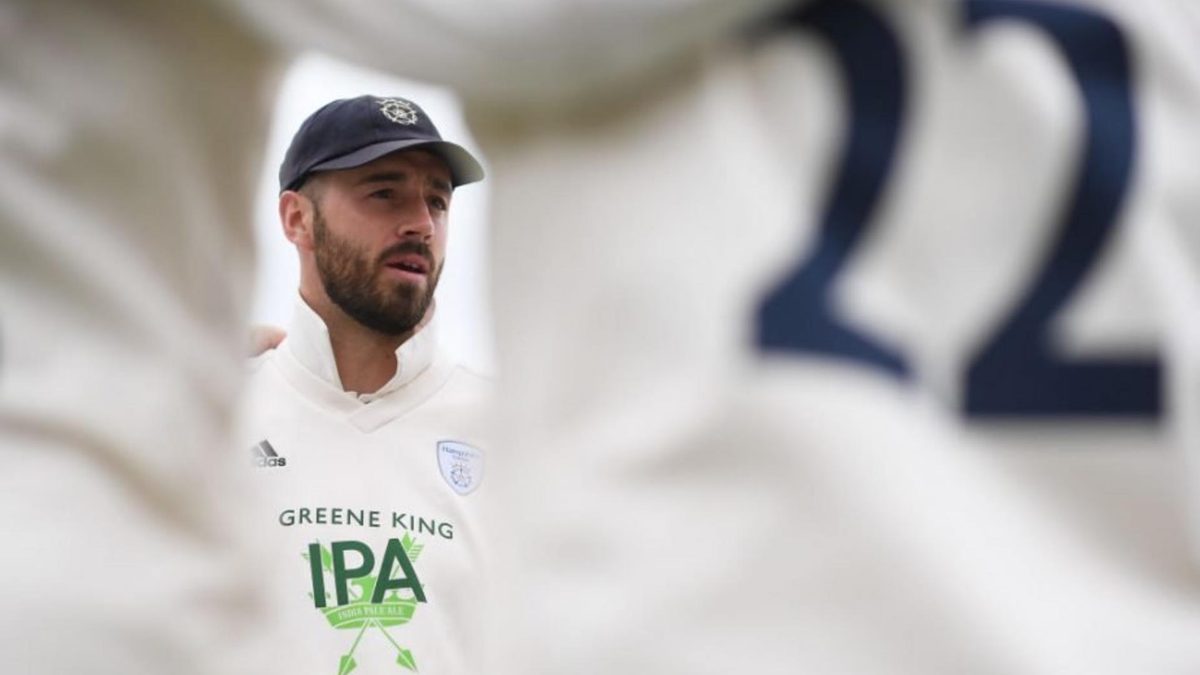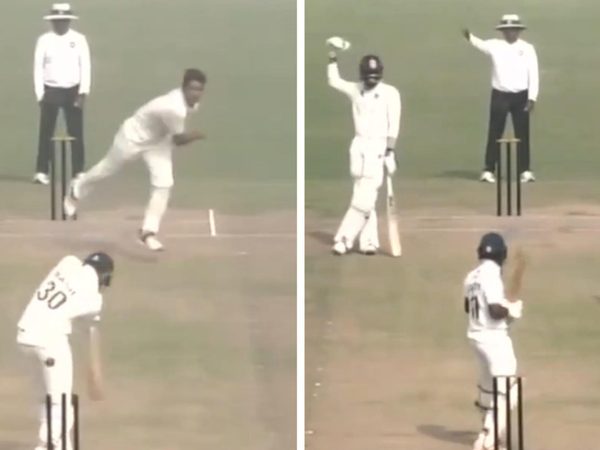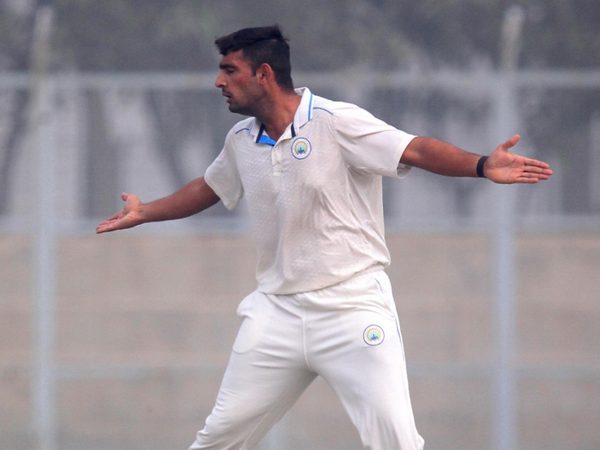
Combing beauty with acts of self-destruction, James Vince remains an enthralling batsman to watch. England shouldn’t forget about him so easily, writes Taha Hashim.
While England falter against the turning ball in India, across the border in Pakistan an Englishman stands tall at the crease and smashes it through the covers. The eye should be on more important contests elsewhere, yet it’s drawn to this. Dressed in blue and green, it’s not the classiest outfit in the world, but those pretty-looking drives sure make up for it.
Alright, some of you are probably rolling your eyes already, so let’s just clarify something early on: this isn’t a reactionary hot-take. Just because England have had a mare doesn’t mean James Vince ought to be dressed up in whites and taking on the red ball in Ahmedabad next week. The truth is, the player himself holds out little hope for such things, and thus directs his gifts elsewhere. Rather, it just feels like we should have a reasoned, well-mannered chat about English cricket’s most enigmatic batsman.
Why? Because sometime last year Vince began to drift out of the conversation almost entirely – perhaps understandably, too. Given three ODIs for a second-string XI against Ireland, there wasn’t much new to be said: two scores of 16 and one of 25 followed a clear pattern to Vince’s international career, that of getting a start but failing to achieve much more. Across 48 international innings, Vince has reached double-figures on 38 occasions. But from there he’s raised his bat for fifty just five times. A century still awaits. As squads were announced after that Ireland series, Vince’s continued absence led to few questions surrounding his whereabouts.
Even after Vince strummed a pair of 90-odds to take Sydney Sixers to successive Big Bash titles, the prolonged shunning of Alex Hales was the main talking point when England announced their T20I squad for the tour of India. After all, Hales has delivered substantial scores for England before and was the one who finished as the highest run-scorer in the BBL, his 543 runs leaving Vince in second place with 537. After his fun in Australia, Vince turned up in Pakistan for another T20 gig and cracked a 55-ball 84 against a Peshawar Zalmi attack featuring Mohammad Irfan, Saqib Mahmood, Mujeeb Ur Rahman and Wahab Riaz earlier this week.
What does this all mean? Probably very little. As a top-order white-ball batsman, Vince can join a long queue, headed by Joe Root of all people, looking on from the outside at England’s T20I team. In ODI cricket, the picture isn’t much different, while in Test cricket, it’s been nearly three years since his last game. Two separate stints have allowed for 13 Tests altogether – a decent sample size – 548 runs at an average of 24.90, and that drive outside off: gorgeous when middled and infuriating when edged. Truthfully, he didn’t really merit that call-up for the 2017/18 Ashes either, having been picked on the back of a middling county season. His detractors have plenty of fair arguments.
But still – and this is what Vince does – there’s a semi-rational case to be made that he shouldn’t disappear completely from English cricket’s thoughts. The irrational part of that comes from the view of the romantics: when Vince teases us at the start of his innings with the grace of his swing and the light touch of his feet, you’d pay good money to watch him carry his bat all the way through. People deserve to see James Vince if he ever does come off.
The more rational side of the argument is derived from actually breaking down his international career into parts. In white-ball cricket he’s only ever been a fill-in, a guy dropped in for the odd game or few. That hardly seems apt for such a rhythmic-looking batsman. After 16 ODIs, Hales – who could easily be listed as one of England’s finest-ever white-ball batsmen – averaged 25.13. Vince sits just marginally worse at 23.
In the Test game, perhaps he merited a longer rope during his second stint. Across six Tests in Australia and New Zealand in 2017/18, Vince finished with 336 runs at 30.54, beginning with a dreamy 83 at the Gabba that seemed to suggest he’d cracked it, and closing with a knock of 76 at Christchurch.
Ahead of England’s next Test he delivered an unbeaten 201 at Taunton for Hampshire, but new chief selector Ed Smith had other plans. “I think actually when I got dropped from the side I was in the best place I’d been,” Vince told Wisden Cricket Monthly last year. “Probably as I was just starting to feel my way in and get used to it a bit was when I stopped playing, so it was quite hard to take.” Across the next 12 months, England used six different players at one down, failing to find much stability in the role until Joe Denly began his stop-gap visit. A few Tests in the summer of 2018 might have offered a more conclusive statement on Vince as a Test cricketer.
Elsewhere, it’s difficult not to disregard the statements of people who’ve dealt with Vince closely. Two years ago Paul Farbrace, having recently departed as England’s assistant coach, told WCM: “If England could find a way to have him in their top three, he would give them a chance in all conditions.” Vince’s inability to kick on at international level stood as Farbrace’s “[one] frustration” during his England stint.
Later that same year, Simon Harmer, the most dangerous spinner in county cricket, provided an honest critique of the way in which the majority of county batsmen played his off-breaks. “Ninety per cent of the time, either they slog-sweep, run down, or they try and block the s*** out of it,” he told WCM. Vince didn’t fall in that bracket. “James Vince is a good player of spin,” Harmer added. “He has the ability to get a single, and the ability to hit boundaries”
It just feels wrong to think that Vince may never play international cricket again. Next month, he turns 30, when batsmen are said to be entering their prime. Perhaps with age and experience, a more mature and measured approach will follow – efficiency to go with the beauty. Maybe we’re already seeing it in franchise cricket. After all, we’re talking about the boy who was England’s leading run-scorer at an Under-19 World Cup with Stokes, Buttler and Root at his side. It could be that we’re still yet to see the best of the man.
The window of opportunity has probably come and gone. Furthermore, even while England’s batsmen have faltered in the subcontinent, it would be downright silly to let that impact selection decisions come the English summer and Australian winter. What should simply be kept in mind is that a batsman with 25 first-class hundreds and bags of ability is still an option somewhere down the line. It would be a waste to forget him.








